This post may contain paid links to my personal recommendations that help to support the site!
You’ve probably stumbled upon the Stanford Machine Learning Course by Andrew Ng on Coursera.
But one question still remains: is the Coursera Stanford Machine Learning Course worth it?
I’ve researched the course and here’s the short answer.
The Coursera Stanford Machine Learning Course by Andrew Ng is worth it. Created as a general introduction to Machine Learning, the course is worth getting for its 60 hours of in-depth content, good mathematical foundation, hands-on exercises, and quality lessons from Stanford University for only $79 USD.
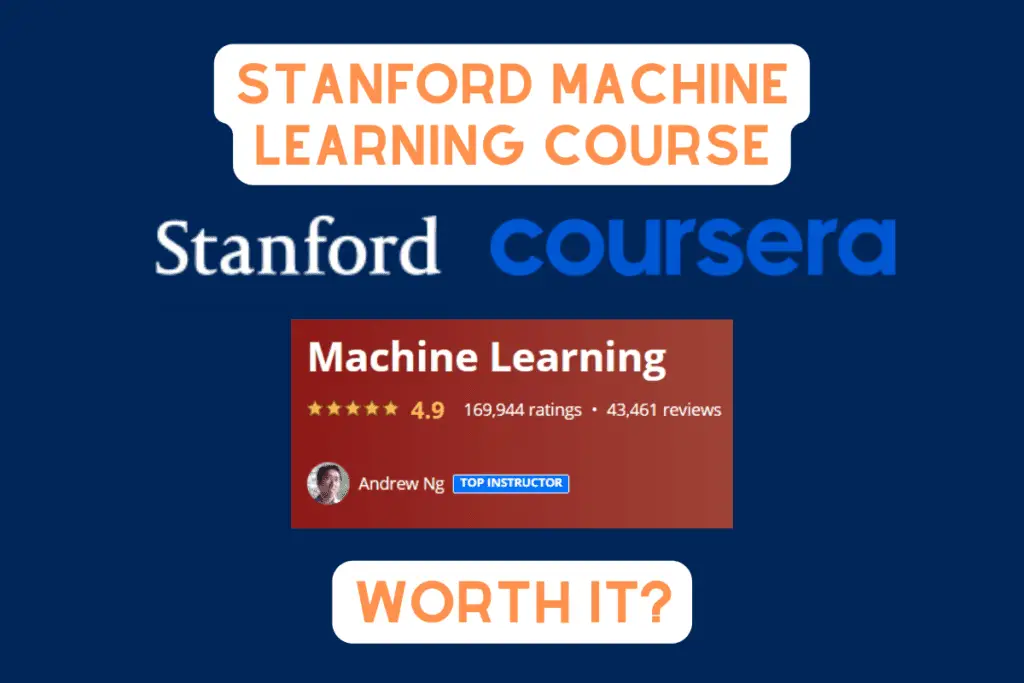
And now your next question might be: why would this course be so worth it?
Read on as I explain the 5 main reasons why the Coursera Stanford Machine Learning Course is worth it + FAQs!
5 Reasons Why the Coursera Stanford Machine Learning Course is Worth It
- The Coursera Stanford Machine Learning Course Provides a Good Overview of Machine Learning Algorithms
- The Coursera Stanford Machine Learning Course Includes A Real-Life Case Study
- The Coursera Stanford Machine Learning Course Gives You a Good Mathematical Foundation
- The Coursera Stanford Machine Learning Course is Taught by Renowned Professor Andrew Ng
- The Coursera Stanford Machine Learning Course Gives You Hands-on Programming Experience

Do any of these reasons catch your eye?
If you’re curious to know about the details on why this course is worth it + FAQs, do read on for more!
1. The Coursera Stanford Machine Learning Course Provides a Good Overview of Machine Learning Algorithms
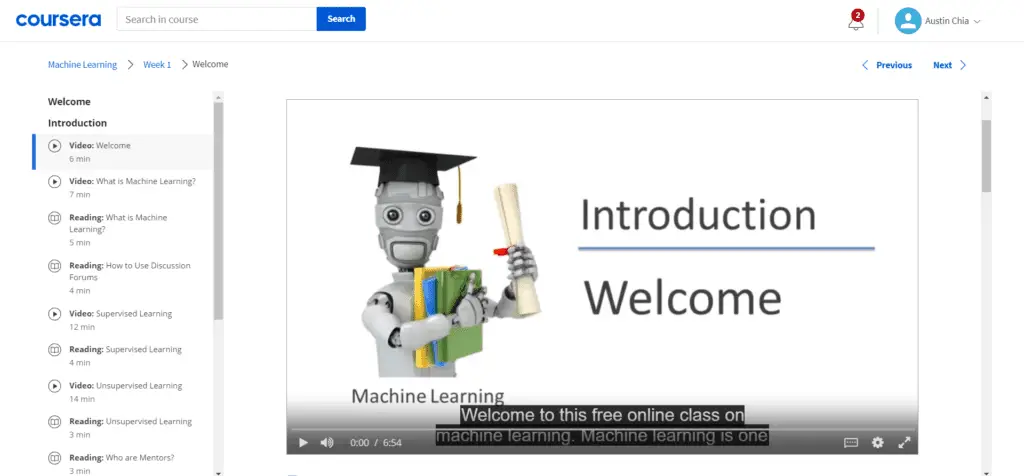
If you’re looking for a machine learning course that gives you a good overview of the many algorithms in machine learning, you’re in luck!
The Coursera Stanford Machine Learning course covers a good 60 hours worth of content on a wide variety of basic algorithms commonly used in applications in data science.
I’m sure you’ll be thrilled to learn each one of them from this course!
Check out the table summary below of each topic/algorithm taught in the course, with the breakdown of the number of hours of learning content:
| Topic | Hours of Learning Content | Amount of Video Content | |
|---|---|---|---|
| 1 | Introduction | 2 | 42 minutes |
| 2 | Linear Regression with One Variable | 2 | 1 hour, 10 minutes |
| 3 | Linear Algebra Review | 2 | 1 hour, 1 minute |
| 4 | Linear Regression with Multiple Variables | 3 | 1 hour, 5 minutes |
| 5 | Octave/Matlab Tutorial | 5 | 1 hour, 20 minutes |
| 6 | Logistic Regression | 2 | 1 hour, 11 minutes |
| 7 | Regularization | 5 | 39 minutes |
| 8 | Neural Networks: Representation | 5 | 1 hour, 3 minutes |
| 9 | Neural Networks: Learning | 5 | 1 hour, 18 minutes |
| 10 | Advice for Applying Machine Learning | 5 | 1 hour, 3 minutes |
| 11 | Machine Learning System Design | 2 | 1 hour |
| 12 | Support Vector Machines | 5 | 1 hour, 38 minutes |
| 13 | Unsupervised Learning | 1 | 39 minutes |
| 14 | Dimensionality Reduction | 5 | 1 hour, 7 minutes |
| 15 | Anomaly Detection | 2 | 1 hour, 31 minutes |
| 16 | Recommender Systems | 5 | 58 minutes |
| 17 | Large Scale Machine Learning | 2 | 1 hour, 4 minutes |
| 18 | Application Example: Photo OCR | 2 | 57 minutes |
| Total | 60 hours | 19 hours, 26 minutes |
Here’s what I liked about the course: It touches on different algorithms that use different concepts.
For example, you’ll be learning about machine learning algorithms ranging from simple linear regression, to logistic regression, to Support Vector Machines, to neural networks.
If you’re intending to get a good grasp of the foundations of all the commonly-used algorithms in machine learning, then this course should be REALLY worth it for you!
2. The Coursera Stanford Machine Learning Course Includes A Real-Life Case Study
Another great benefit of the Coursera Stanford Machine Learning Course is the real-life case study at the end of the course.
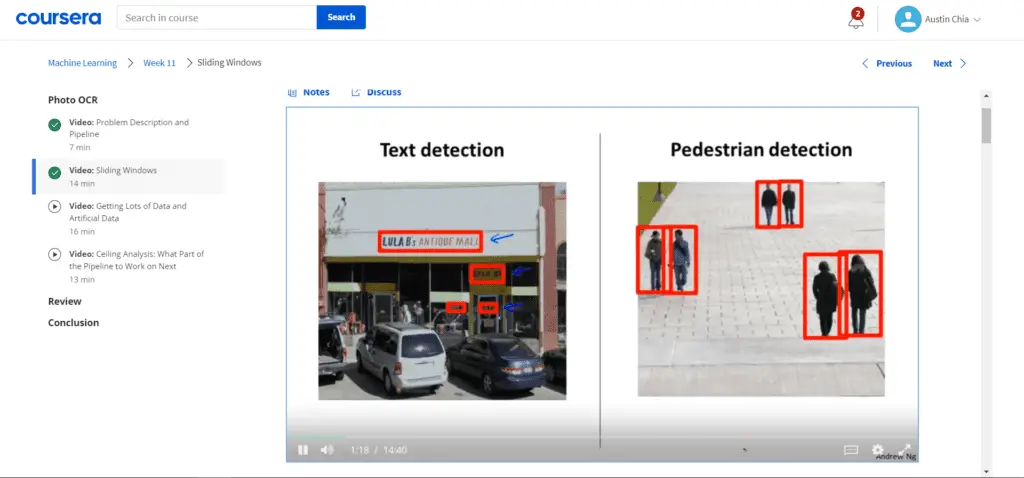
The case study highlights all the considerations to take when tackling the application of machine learning in Photo OCR.
Photo OCR (Optical Character Recognition) is the conversion of text in a photo into data or code that machines can understand.
Here’s what I really liked about this case study:
The Photo OCR case study example in the course gave me a better understanding of how algorithms and concepts learned in the earlier topics can be applied well in a real-life example.
If you’re looking to also start applying your knowledge in machine learning in your work or school then this case study is also another good reason why the Coursera Stanford Machine Learning Course is worth it!
For example, machine learning is used in disability in data science!
3. The Coursera Stanford Machine Learning Course Gives You a Good Mathematical Foundation
The Coursera Stanford Machine Learning Course has a pretty big focus on mathematical concepts behind the various algorithms.
And that’s great!
Here’s why:
Having a deep understanding of the mathematical formulas behind the algorithms will help develop you to think beyond just running algorithms without thinking.
As you go through the course, you’ll realize that many of the videos are of a simple, whiteboard-style demonstration of mathematical formulas.
Check out this screenshot of the Linear Regression section below:
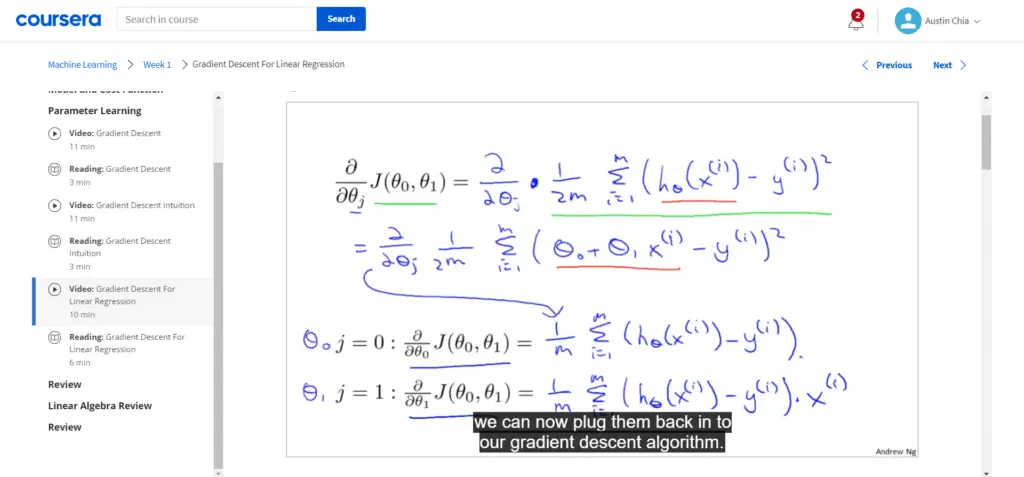
I personally found these video lectures on formula explanations really clear and helpful! I like to rewind these videos too, so I can grasp the concept of the algorithm formulas fully.
Now you might be thinking, why would I want to learn so much about these formulas?
Here are some benefits of learning the mathematical foundations of machine learning:
- To build more efficient models
- To adapt machine learning models to fit domain-specific problems
- To debug algorithms well
- To stand out among other job applicants
With these 4 benefits, I hope that you’ll still be motivated to pick up these basic mathematical foundations.
If you’re worried about how tough it will be, please be assured that the Coursera Stanford Machine Learning Course has a really great introduction to each algorithm.
Most should be able to understand them pretty quickly, with some time!
At least you’ll be in the good hands of Stanford Professor Andrew Ng!
More on this in the next point.
4. The Coursera Stanford Machine Learning Course is Taught by Renowned Professor Andrew Ng
If you’re going to want to take on a machine learning course, you’ll need to take it from the best instructors.
This is where the Coursera Stanford Machine Learning Course will help you!
The Coursera Stanford Machine Learning Course is completely taught by one person – Andrew Ng from Stanford University.
Andrew Ng is a famous machine learning adjunct professor at Stanford University. In fact, he’s also the co-founder of Coursera itself!

This just means that you’ll only be learning from the best if you’re intending to take the Coursera Stanford Machine Learning Course!
However, there are some limitations to the course, since the video lectures were made pretty long ago by Andrew Ng.
Since these videos were made a while back, the video resolution was relatively poor.
Refer to my screenshot of one of the videos below:

These videos might not be at the same resolution quality level as the latest courses on Coursera, like the Google Digital Marketing & E-commerce Professional Certificate.
Nonetheless, I still found the videos clear enough at 720p, which was good enough for me, considering that the quality of the teaching was still excellent.
If you don’t mind the lower resolution, then the Coursera Stanford Machine Learning Course would be perfect for you.
5. The Coursera Stanford Machine Learning Course Gives You Hands-on Programming Experience
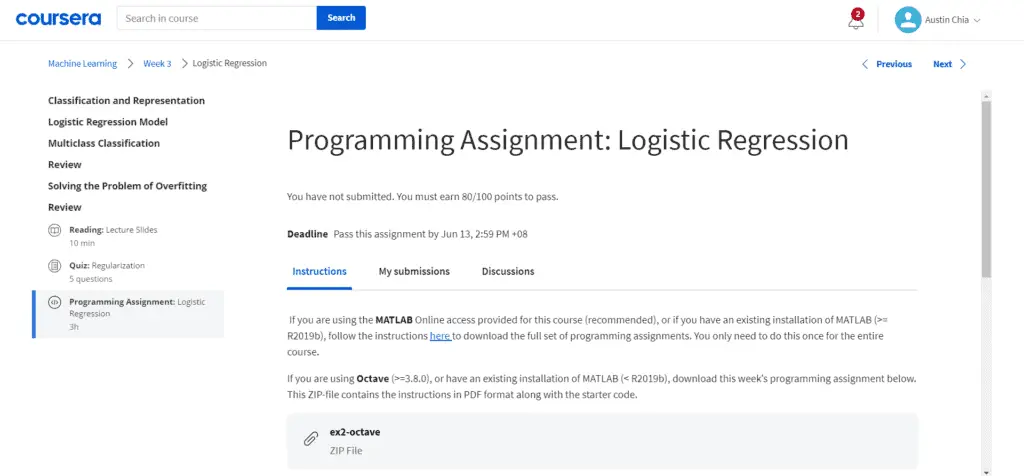
You’re probably thinking of taking a course that can actually give you practical experience, rather than just mathematical explanations.
Not to worry, the Coursera Stanford Machine Learning Course does deliver on that end (and in fact pretty well)!
Just have a look at this summary table of assignments across the topics in the Coursera Stanford Machine Learning Course and you’ll know!
| Topic | Does It Have a Programming Assignment? | Title of Programming Assignment | |
|---|---|---|---|
| 1 | Introduction | No | – |
| 2 | Linear Regression with One Variable | No | – |
| 3 | Linear Algebra Review | No | – |
| 4 | Linear Regression with Multiple Variables | Yes | Linear Regression |
| 5 | Octave/Matlab Tutorial | No | – |
| 6 | Logistic Regression | Yes | Logistic Regression |
| 7 | Regularization | No | – |
| 8 | Neural Networks: Representation | Yes | Multi-class Classification and Neural Networks |
| 9 | Neural Networks: Learning | Yes | Neural Network Learning |
| 10 | Advice for Applying Machine Learning | Yes | Regularized Linear Regression and Bias/Variance |
| 11 | Machine Learning System Design | No | – |
| 12 | Support Vector Machines | Yes | Support Vector Machines |
| 13 | Unsupervised Learning | No | – |
| 14 | Dimensionality Reduction | Yes | K-Means Clustering and PCA |
| 15 | Anomaly Detection | No | – |
| 16 | Recommender Systems | Yes | Anomaly Detection and Recommender Systems |
| 17 | Large Scale Machine Learning | No | – |
| 18 | Application Example: Photo OCR | No | – |
| Total | 8 Programming Assignments |
As you can see, there’s a total of 8 programming assignments where you’ll get to apply your new knowledge of algorithms into practice!
Here’s a screenshot of what the assignments look like:
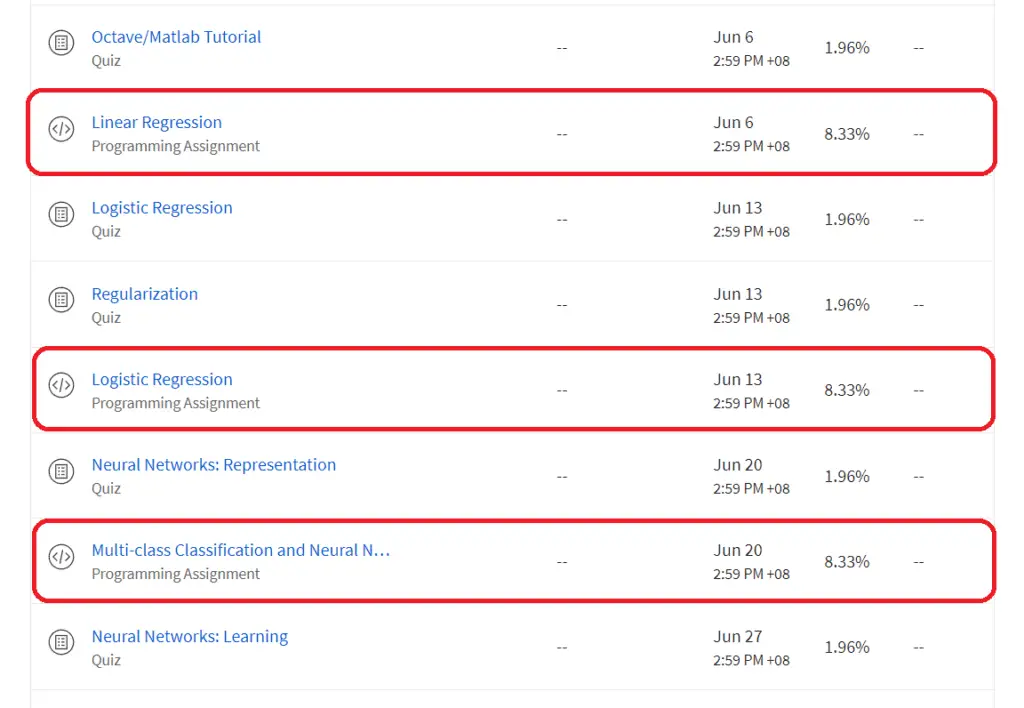
At the end of most topics, you’ll be given a programming assignment to wrap things up and code out the algorithm.
Here’s a sneak peek of what the assignment would be like:
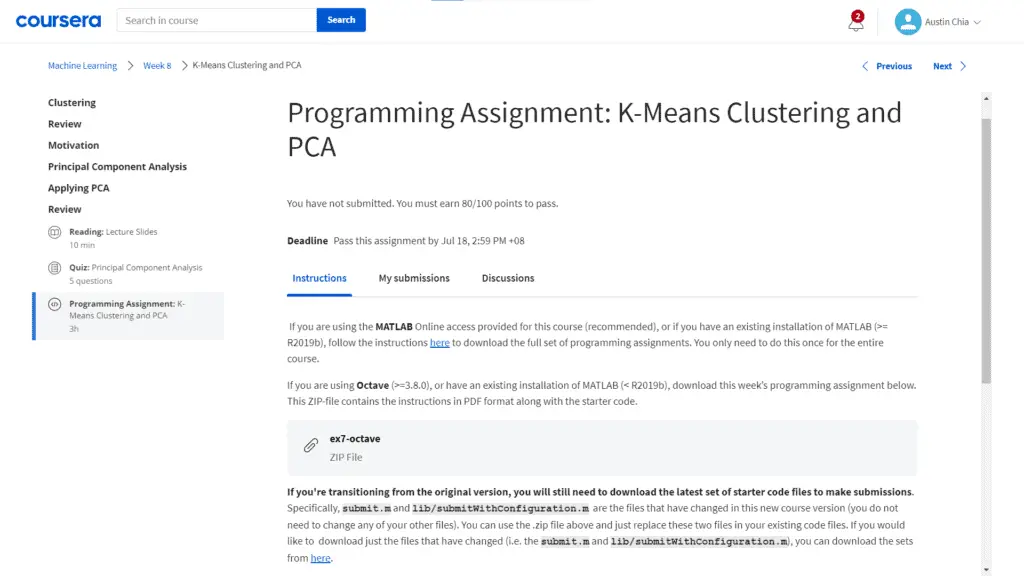
However, there’s just something that I didn’t really enjoy about these programming assignments.
And that’s because the assignments require either the Octave or MATLAB scientific computing languages.
If you don’t mind learning using these older and more academic programming languages, then the Coursera Stanford Machine Learning Course is actually still very worth it for you!
Related Questions
Is the Coursera Stanford Machine Learning Course Good?
The Coursera Stanford Machine Learning Course is good. The course covers an excellent foundation for a wide variety of commonly-used machine learning algorithms and provides hands-on programming assignments for only $79 USD. However, the course teaches MATLAB and Octave instead of Python, which some may not prefer.
If you’re intending to just get an overview of the most common machine learning algorithms as well as the mathematical formulas behind them, then the Coursera Stanford Machine Learning Course would be good for you!
However, if you’re thinking of learning the basics of Python instead of MATLAB, you can consider Coursera’s highly-rated Python for Everybody Course.
How Much Does The Coursera Stanford Machine Learning Course Cost?
The Coursera Stanford Machine Learning Course by Andrew Ng costs USD $79. This course is paid through a one-time fee that unlocks the entire course of 60 hours of high-quality content. However, auditing the course without any cost is possible. Auditing the course does not provide any certificate upon completion.
If you’re thinking of purchasing the cost, you should consider 2 main options.
- You can purchase the course at a one-time fee of USD $79 (includes certificate)
- You can access the course for free (excludes certificate)
Here’s what Coursera showed me when I enrolled in the course:

My recommendation: Try out the course for the first week for free FIRST. Commit to the $79 only after you’ve deemed it as worth your money!
Is the Coursera Stanford Machine Learning Course Free?
The Coursera Stanford Machine Learning Course by Andrew Ng is not free. The entire course costs USD $79 to enroll. However, the learning materials can be accessed for free on Coursera but certificates are excluded.
Is It Worth Paying for Andrew Ng’s Stanford Machine Learning Course on Coursera?
It is worth paying for the Coursera Stanford Machine Learning Course by Andrew Ng. The course provides 60 hours of in-depth quality content on the mathematical concepts behind common machine learning concepts as well as programming assignments. The content is also delivered by renowned Stanford Professor Andrew Ng.
If you’re on the fence about deciding if the Stanford Machine Learning Course on Coursera is worth paying, you’ll need to take note of the following differences:
| Purchasing the Stanford Machine Learning Course | Auditing the Stanford Machine Learning Course | |
|---|---|---|
| Cost | USD $79 | $0 |
| Certificate | Has certificate | No certificate |
Although it looks like there isn’t much to gain from paying for a course, you should know that completing a course that you don’t have to pay for is very unlikely.
Here’s why:
Investing some money into a course gives you the right level of motivation to get going and achieve the goals you’ve set.
In this case, if you choose the Paid option, you’re more likely to incentivize yourself to complete the course and learn some new skills!
Moreover, you’ll be receiving a certificate that’s shareable to your network on LinkedIn, which can be a magnet for conversation with a company recruiter!
Here’s what Coursera says about this course:

A good 17% of those who took the course even had a tangible career benefit!
My recommendation: Try out the course for the first week for free FIRST. Commit to the $79 only after you’ve deemed it as worth your money!
How Long Does It Take To Complete the Coursera Stanford Machine Learning Course?
It takes 6-8 weeks to complete the Coursera Stanford Machine Learning Course by Andrew Ng. However, this will vary depending on previous machine learning, or programming background, learning speeds, and hours committed per week. Although the course was designed to complete in 11 months, most should complete it earlier.
For Faster Learners with Experience
If you’re comfortable learning faster, you can try committing 10 hours of learning each week.
This should help you complete the course within 6 weeks.
No Previous Experience
If you have no prior experience, you can try committing to 7.5 hours of learning each week.
This should help you complete the course within 8 weeks.
My recommendation: Learn the course over an 8-week period.
This slower learning method allows you to digest content at the right pace.
Moreover, you’ll only be paying a fixed cost of USD $79. There’s no monthly subscription fee that would motivate you to learn any faster than you can learn.
Is the Coursera Stanford Machine Learning Course Easy?
The Coursera Stanford Machine Learning Course by Andrew Ng is not easy. The course covers in-depth content on machine learning algorithms, explained using mathematical formulas and programming assignments. However, this makes the course worth it, since this course would teach beyond only easy concepts.
If you’re intending to get into machine learning in your career you should’ve already been prepared for problems that aren’t easy.
That’s why I view this course as REALLY worth it since you won’t only be achieving something that’s only easy. You’ll have a good command of the basic machine learning algorithms!
Is the Coursera Stanford Machine Learning Course Good for Beginners?
The Coursera Stanford Machine Learning Course by Andrew Ng is good for beginners. The course provides an overview of the most essential machine learning algorithms. The mathematical foundations of each algorithm are explained in detail by an experienced Stanford Professor, Andrew Ng, which is beginner-friendly.
Is the Coursera Stanford Machine Learning Course Hard?
The Coursera Stanford Machine Learning Course by Andrew Ng is hard. The course covers in-depth content on machine learning algorithms, explained using mathematical formulas and programming assignments. However, this makes the course worth it, since this course would teach beyond only basic concepts.
Is the Coursera Stanford Machine Learning Course Useful?
The Coursera Stanford Machine Learning Course by Andrew Ng is useful. The course is useful in providing a great introduction to the field of machine learning and its algorithms. The course is highly technical and practical, which is useful for first-time learners to have hands-on training in machine learning.
Is the Coursera Stanford Certificate Valuable?
The Coursera Stanford Machine Learning Course Certificate is valuable. The certificate received upon completion of the Coursera Stanford Machine Learning course is valuable for sharing to network connections on LinkedIn and demonstrating initiative to learn. However, the certificate alone is not enough to get a job.
If you’re thinking about whether getting the Coursera Stanford Machine Learning Course certificate is of ANY value, you should consider the following 2 things the certificate can do for you:
- Sharing to recruiters in your network on LinkedIn
- Demonstrating your initiative to learn new things
Although not as valuable as a professional certificate from Coursera such as the IBM Data Science Profesional Certificate, you’ll still be getting a good achievement!
You might also want to check out this other post I wrote on data analytics certificates and if they are worth it.
Is the Coursera Stanford Machine Learning Course Still Relevant?
The Coursera Stanford Machine Learning Course by Andrew Ng is still relevant. Many of the mathematical concepts taught in the course are the basics that are still being applied to technologies used today. These mathematical formulas are fundamental parts of machine learning and are always relevant within the field.
Is the Andrew Ng Course Sufficient?
The Coursera Stanford Machine Learning Course by Andrew Ng is not sufficient. The course only provides an introduction to the fundamental concepts of machine learning algorithms. More hands-on projects and advanced knowledge is required to have a deeper understanding of machine learning as a whole.
In my opinion, just completing the Coursera Stanford Machine Learning Course by Andrew Ng is still far from being enough.
To get a better understanding of topics in machine learning you’ll want to consider doing data science projects or working on more advanced concepts using Python programming.
A good place to start would be the IBM Data Science Professional Certificate!
Or you might also want to consider boot camps, if you’re thinking of fast-tracking your learning.
Final Thoughts
The Coursera Stanford Machine Learning Course is a great course and I recommend it to anyone thinking of learning machine learning fundamentals for the first time!
If you’re buying the course and would like to support the site, do consider using my affiliate link to purchase at no extra cost to you.
Thanks for reading!
Sources
My Favorite Learning Resources:
My Recommended Learning Platforms!
| Learning Platform | What’s Good About the Platform? | |
|---|---|---|
| 1 | Coursera | Certificates are offered by popular learning institutes and companies like Google & IBM |
| 2 | DataCamp | Comes with an integrated coding platform, great for beginners! |
| 3 | Pluralsight | Strong focus on data skills, taught by industry experts |
| 4 | Stratascratch | Learn faster by doing real interview coding practices for data science |
| 5 | Udacity | High-quality, comprehensive courses |
My Recommended Online Courses + Books!
| Topic | Online Courses | Books | |
|---|---|---|---|
| 1 | Data Analytics | Google Data Analytics Professional Certificate | – |
| 2 | Data Science | IBM Data Science Professional Certificate | – |
| 3 | Excel | Excel Skills for Business Specialization | – |
| 4 | Python | Python for Everybody Specialization | Python for Data Analysis |
| 5 | SQL | Introduction to SQL | SQL: The Ultimate Beginners Guide: Learn SQL Today |
| 6 | Tableau | Data Visualization with Tableau | Practical Tableau |
| 7 | Power BI | Getting Started with Power BI Desktop | Beginning Microsoft Power BI |
| 8 | R Programming | Data Science: Foundations using R Specialization | Learning R |
| 9 | Data Visualization | – | Big Book of Dashboards |

